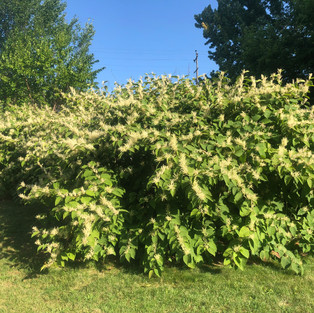When Aliens Attack
- Genesee Conservation District

- May 15, 2020
- 3 min read
"What if I told you that aliens have been spotted nearby?
They can grow up to fifteen feet tall.
They release special chemicals that prevent other things from living nearby.
They are so strong that they can break through the foundation of your house and come right in.
They have incredible regenerative powers and can survive being ripped apart.
They can even clone themselves from a chunk as small as your fingernail.
They have come from a far away land with an inhospitable, rocky environment.
They can withstand freezing temperatures, acid, dismemberment, and even fire.
They are eager to establish themselves right here in our very own backyards...
They might even be moving in at this very moment."
*Children look at each other in awe with their mouths agape as they listen to these chilling words presented to them from an enthusiastic yet intent presenter*
It's true.
Alright. So it may be a bit imaginative with some flavorful descriptors added for entertainment purposes, but technically it is all still true. The above description is not unlike many engagements our GiLLS CISMA coordinator has presented to discuss this serious matter with groups of curious school children. Adults have responded with visible perturbations at times as well though. Something as harrowing as this seems just a bit too wild and weird to be real.

The aliens we are referring to here are not the typical, monster-like creatures invading our planet from faraway stretches of the universe that are conjured up by imaginative science-fiction writers. Rather, these creatures are from right here on our very own planet, hailing from other countries around the world. In the description above, we are referring to the ever-so-problematic Japanese knotweed.
In its native land of Japan, it can be found growing on dry, craggy cliffs surrounding volcanoes. They have evolved to not only tolerate, but thrive in conditions that are harsh for many other species. Here in Mid-Michigan, it grows in a wide variety of conditions and can tolerate full sun, shade, drought, standing water, high salinity, and a wide range of temperatures. The large woody rhizomes can penetrate into the earth as far as 10 feet deep and as far as 40 feet out. These rhizomes are allelopathic, meaning they release chemicals that kill off or reduce the growth of other vegetation nearby. Stem or rhizome chunks can regrow entire thick clonal stands from a piece as small as 1/2 inch.
Cutting, pulling, mowing, burning, and other treatments often remove the growth above ground, but these methods only stimulate the rhizome below to spread further. These rhizomes are so strong that they can grow through concrete and pavement which leads to extensive damage to foundations of homes, septic systems, infrastructure, drainage, utilities, and much more. Reports have even suggested that the rhizome can lay dormant underground for up to 20 years! In the UK, Japanese knotweed has been the center of many lawsuits and is regarded as the worst invasive species they have ever had to deal with. Estimates show that it has caused an overall decrease in property values by 10%, equating almost 20 billion pounds or over $25 billion US dollars.
Recent surveys and sightings right here in Michigan have (unsurprisingly) shown that known patches of Japanese knotweed have eagerly erupted from their winter slumbers. Some areas have stalks over three feet tall already. The new growth looks somewhat like reddish scaly stalks of asparagus and is frequently accompanied by the bamboo-like stalks of last year's growth. These plants have been known to grow as fast as 8 inches per day! These young sprouts will turn into towering giants in no time at all. If you see this plant, please report it to the MISIN (Midwest Invasive Species Information Network) or to your local CISMA coordinator. We can help you in trying to figure out the best way to remove or manage this pesky plant which is quickly spreading through Genesee County as well as the other Mid-Michigan counties in the GiLLS CISMA (Genesee, Lapeer, Livingston, and Shiawassee).
Japanese knotweed can grow up to 15 feet tall with a greenish stem that often has purple splotches. The stems are hollow and segmented giving it a bamboo-like appearance. The leaves can be a reddish purple color when young and and progress into into a green semi-triangular leaf that can reach 7 inches in length and 4 inches in width arranged alternately along a zigzagged stem. Flowers are small and whitish in dense clusters on the leaf axils appearing in mid-August. See the pictures below for a better look.
Japanese knotweed is a prohibited plant in the state of Michigan. Prohibited species are illegal to possess, spread, or offer for sale. Exceptions include possession for identification or as part of control/management. This legislation is stated as part of Michigan's Natural Resource Environmental Protection Plan.
Keep your eyes open and look for this pesky species. The earlier it is detected, the better the chances of control or eradication.





















Comments